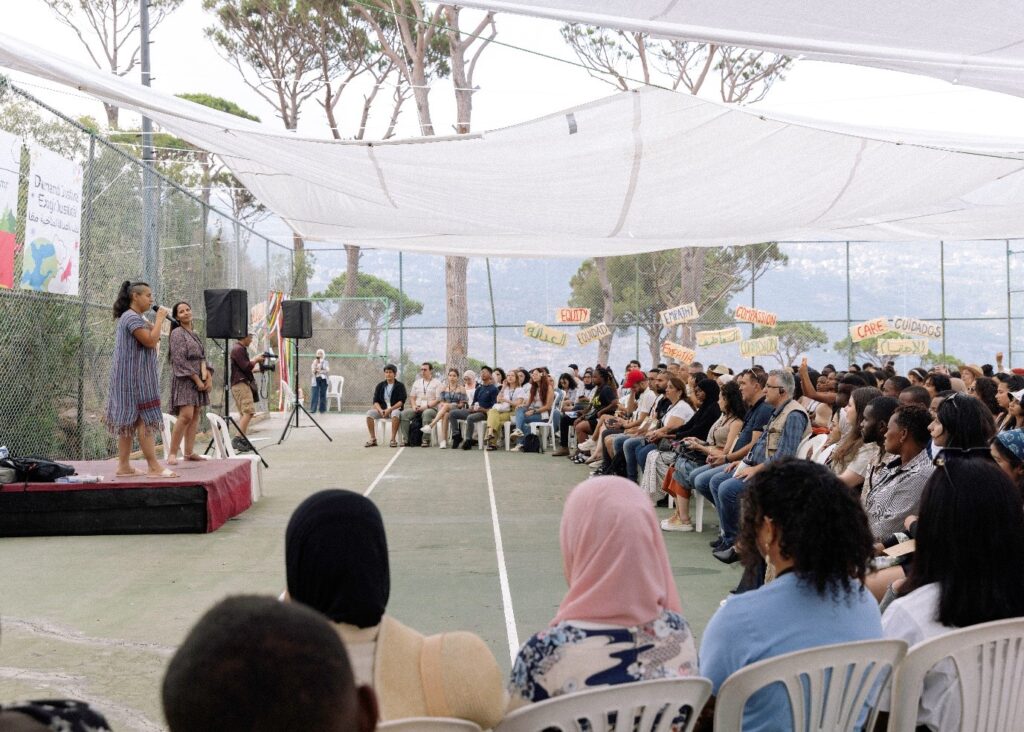Oxfam Novib staff on four lessons for digital activism, drawn from their “E-motive” peer-to-peer learning project that connected campaigners across borders.

There are many challenges to building effective digital movements: how do you get visibility and sustained meaningful engagement? How do make sure you are building an inclusive movement and not excluding certain groups? How about the (digital) safety of activists in a context of shrinking civic space and widespread hostility and trolling, especially on social media?
This blog lays out four take-aways from peer-to-peer learning exchanges in Nigeria and Mozambique between strong digital movements in these countries and the African Activists for Climate Justice (AACJ) project on how to enhance digital movement building. The AACJ uses digital means to mobilize citizens, companies, and governments to advance climate justice in Senegal, Somalia, Mozambique, Burkina Faso, Ethiopia, Nigeria, South Africa, Kenya and the Netherlands.
‘Building from offline mobilisation not only creates a strong foundation, but also nurtures authentic relationships within local communities – where the mission resides’
The exchange of learning was facilitated by Oxfam Novib’s E-motive methodology. This peer-to-peer learning methodology is based on the fact that the best solutions to empower communities and to tackle poverty and inequalities already exist worldwide – waiting to be unlocked. For over a decade, E-motive has tried to unlock that potential, by connecting professionals and change makers to learn from each other.
So, what were key insights about building digital movements shared between the AACJ and its peers?
1. Think before you act: crafting a strategic foundation
The first step for any online activist is to map out strategy. This should put at its heart a clear, well-defined common goal, acting as a guiding light to steer collective efforts. A key exercise will be to map stakeholders and the spectrum of allies, also mapping existing initiatives that share your common goal. It is also important to identify risks and do mitigation planning.
Alongside strategy, it’s vital to have a clear sustainability plan that specifies how to recruit members to your movement and keep them engaged. That’s why it is so vital to be explicit about the shared goal as you set the stage for safe and purposeful engagement, collective empowerment, and ultimately, tangible and positive change.
2. Where is your movement in the real world? The importance of offline foundations
Effective digital mobilization often demands a solid grounding in offline efforts. That’s because effective campaigns aren’t conjured up overnight: they depend on grassroots work that resonates with your core audience. Building from offline mobilisation not only creates a strong foundation, but also nurtures authentic relationships within local communities – where the mission resides.
In rallying people for change, offline and online mobilisation efforts should complement each other. Where offline efforts ensure authenticity, ownership and grounding; online efforts provide potential to mobilise far more people, to expand the movement beyond its original, geographical, boundaries and to build pressure on targets.
3. The power of storytelling: weaving the thread between online and offline mobilisation
Storytelling can be a golden thread to stitch together online and offline mobilisation efforts. Stories humanise the cause, evoke empathy and transcend screens to touch hearts. They breathe life into statistics, and encourage people to take concrete actions. Storytelling also provides an opportunity for everyone to see the human need or results of action, as well as to identify what’s missing when organising and to reflect on what to do better next time. Community-grounded stories amplified at local, national or global platforms, can be the bridge between digital activity and real-world impact, ensuring that the fire ignited online fuels the engines of change offline.
4. Think about the risks to activists
In open digital spaces, especially social media, the ability to discuss and debate complex topics and freedom of expression, are under threat from censors, harassers, and online trolls. As activists organise, oppressors are also organising. Much of the time, these oppressors have more resources at their disposal to resist the organising of activists. This resisting often turns violent and compromises activists’ safety.
Within such a context, therefore, it’s imperative that activists are clear about identifying and mapping all possible risks, put in place contingent and mitigation plans, and safe fallback positions. This includes assessing potential threats, understanding the vulnerabilities of their communication channels, and constantly adapting to new challenges in order to ensure the safety and effectiveness of their campaigns.
In efforts to manage some of these risks, Oxfam and partners through AACJ established the Power to Voices platform (PtV). This is a space as safe as possible for activists to come together and keep organising, mobilising, connecting struggles, and strengthening their movements. More and more groups of activists have started to use the platform. Often, these digital groups on PtV started after a physical engagement, such as a workshop, training, or offline campaign activity.
The link between the screen and the street
So digital mobilisation isn’t by itself a replacement for traditional activism; rather, it is best seen as an amplification tool for essential work already being done on the ground, extending its reach (inter)nationally. Hence each click/like/share, each story told, and each offline action jointly contributes towards a more just and sustainable world.
This blog was written by Marieke Meeske and Philip Kabuye, building on inputs from Adelson Rafael, Henry Ushie, Kenneth Akpan, Sergio Zimba, Adaji Israel, Dercio Tsandzana, Rita Abiodun and Carin Boersma. All have been part of the E-motive facilitation team to foster peer-to-peer learning on digital mobilisation.